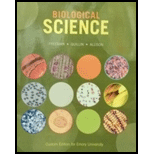
Concept explainers
To review:
The function of bindin in fertilization.
Introduction:
Bindin is a protein that presents in the acrosome of the sperm of many aquatic animals, for example, sea urchin. This protein has a role in species-specific sperm-egg recognition. Moreover, bindin plays a central role in fertilization process.
Explanation of Solution
In the case of aquatic animals, fertilization (fusion of egg and sperm) is external that is fertilization takes place in open sea water, not inside the body. Problem with this type of fertilization is sperm and egg of many aquatic animals are exposed in the same seawater. So cross-fertilization may occur.
In order to produce a viable embryo, the sperm of one species must recognize egg of its own species. In 1970, Victor Vacquier isolated a 30,500-Da protein from the Strongylocentrotus purpuratus acrosome and found it to be able of binding to the eggs belonging to same species. He also found out Bindin isolated from other sea urchin species are indeed different. This protein prevents cross-fertilization and is species specific.
The vitelline envelope of the egg has a specific receptor or binding site for acrosomal bindin. These receptors can differentiate between bindin of two closely related species (same genus). so, the sperm of one specific species can only bind to the egg of same species. This way aquatic animals like sea urchin prevent cross-fertilization and help in species-specific egg and sperm recognition and fusion.
Therefore, it can be concluded that the cross-fertilization is the big problem in the case of animals that practice external fertilization. To prevent this a species-specific protein called bindin present in the acrosome of the sperm and its specific receptors are present in the egg of the same species. This way sperm of one species can only fertilize the egg on its own species.
Want to see more full solutions like this?
Chapter 23 Solutions
Biological Science (Custom)
 Human Anatomy & Physiology (11th Edition)BiologyISBN:9780134580999Author:Elaine N. Marieb, Katja N. HoehnPublisher:PEARSON
Human Anatomy & Physiology (11th Edition)BiologyISBN:9780134580999Author:Elaine N. Marieb, Katja N. HoehnPublisher:PEARSON Biology 2eBiologyISBN:9781947172517Author:Matthew Douglas, Jung Choi, Mary Ann ClarkPublisher:OpenStax
Biology 2eBiologyISBN:9781947172517Author:Matthew Douglas, Jung Choi, Mary Ann ClarkPublisher:OpenStax Anatomy & PhysiologyBiologyISBN:9781259398629Author:McKinley, Michael P., O'loughlin, Valerie Dean, Bidle, Theresa StouterPublisher:Mcgraw Hill Education,
Anatomy & PhysiologyBiologyISBN:9781259398629Author:McKinley, Michael P., O'loughlin, Valerie Dean, Bidle, Theresa StouterPublisher:Mcgraw Hill Education, Molecular Biology of the Cell (Sixth Edition)BiologyISBN:9780815344322Author:Bruce Alberts, Alexander D. Johnson, Julian Lewis, David Morgan, Martin Raff, Keith Roberts, Peter WalterPublisher:W. W. Norton & Company
Molecular Biology of the Cell (Sixth Edition)BiologyISBN:9780815344322Author:Bruce Alberts, Alexander D. Johnson, Julian Lewis, David Morgan, Martin Raff, Keith Roberts, Peter WalterPublisher:W. W. Norton & Company Laboratory Manual For Human Anatomy & PhysiologyBiologyISBN:9781260159363Author:Martin, Terry R., Prentice-craver, CynthiaPublisher:McGraw-Hill Publishing Co.
Laboratory Manual For Human Anatomy & PhysiologyBiologyISBN:9781260159363Author:Martin, Terry R., Prentice-craver, CynthiaPublisher:McGraw-Hill Publishing Co. Inquiry Into Life (16th Edition)BiologyISBN:9781260231700Author:Sylvia S. Mader, Michael WindelspechtPublisher:McGraw Hill Education
Inquiry Into Life (16th Edition)BiologyISBN:9781260231700Author:Sylvia S. Mader, Michael WindelspechtPublisher:McGraw Hill Education





